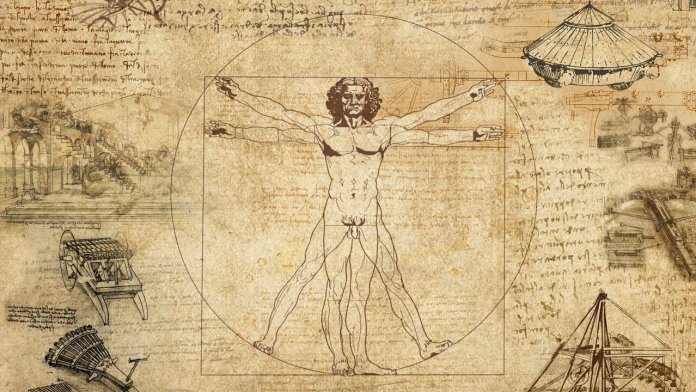A great artist, a pioneer of medical research, an ingenious inventor - and it's all about one person, Leonardo da Vinci. It was hundreds of years ahead of its time. You've probably heard that in your famous paintings he applied the principle of the golden ratio and created drawings of "flying machines" 400 years before the first flight of the Wright brothers. Pretty impressive, right? But this is just the beginning. We will tell you about the most famous inventions of Leonardo da Vinci.
20. Garlic press
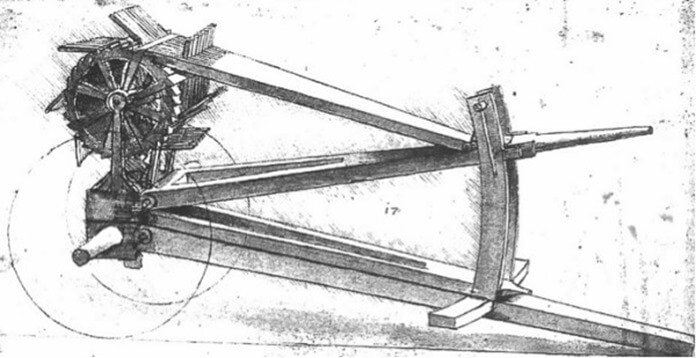 In Italy, this unpretentious object is still sometimes called "Leonardo". This manual garlic press has reached the 21st century in almost the same form in which it was conceived by its creator.
In Italy, this unpretentious object is still sometimes called "Leonardo". This manual garlic press has reached the 21st century in almost the same form in which it was conceived by its creator.
19. Bicycle
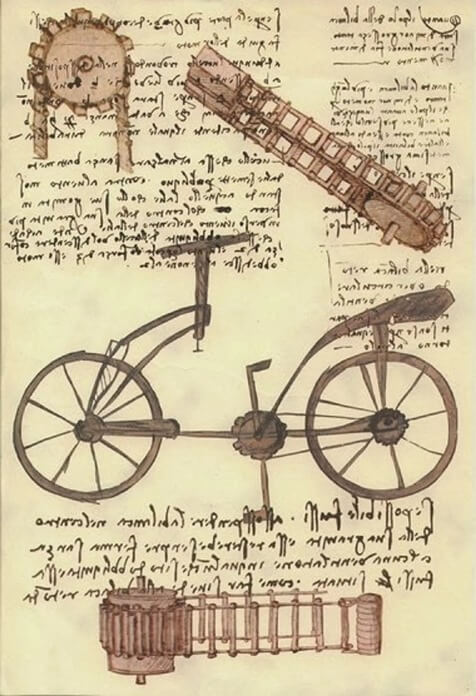 On page 133 of Leonardo da Vinci's Atlantic Code, there is a drawing that some consider the prototype of a bicycle, while others are either a fake or the creation of the great Italian's students. We do not know. which of them is right, and we leave it to you, dear readers, to make a choice in favor of one of the theories.
On page 133 of Leonardo da Vinci's Atlantic Code, there is a drawing that some consider the prototype of a bicycle, while others are either a fake or the creation of the great Italian's students. We do not know. which of them is right, and we leave it to you, dear readers, to make a choice in favor of one of the theories.
18. Sluice with sliding doors
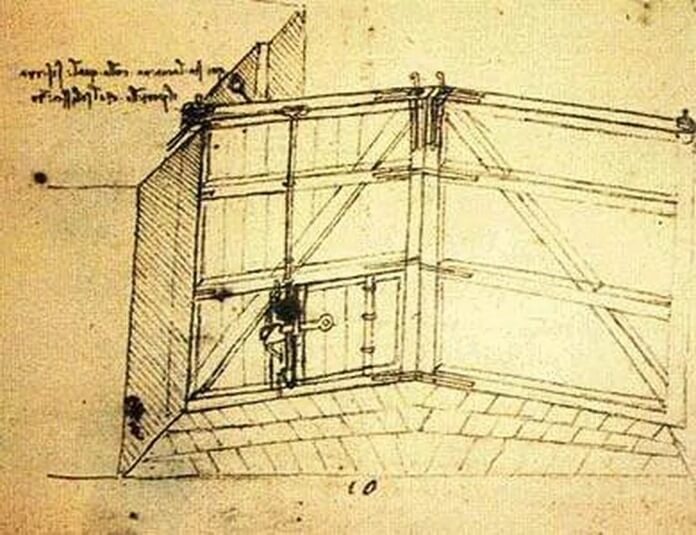 This type of lock is still used today on virtually any canal or waterway. Leonardo's designs were efficient and did their job exactly as the inventor wanted.
This type of lock is still used today on virtually any canal or waterway. Leonardo's designs were efficient and did their job exactly as the inventor wanted.
The airlock consisted of two shutters at an angle of 45 degrees, which met at one point. They resembled the letter V in shape. When the oncoming stream of water hit them, the shutters moved tightly.
At the bottom of the large gate, Leonardo proposed to make a small sluice gate, bolted. This would allow as much water to flow as needed to equalize the pressure on both sides of the large gate.
17. Spotlight
 The Italian "universal man" made a box, inside which was a large burning candle in a candlestick, and in one of the walls was a glass lens. Such a simple design was created by Leonardo for theatrical needs.
The Italian "universal man" made a box, inside which was a large burning candle in a candlestick, and in one of the walls was a glass lens. Such a simple design was created by Leonardo for theatrical needs.
16. Portable piano player
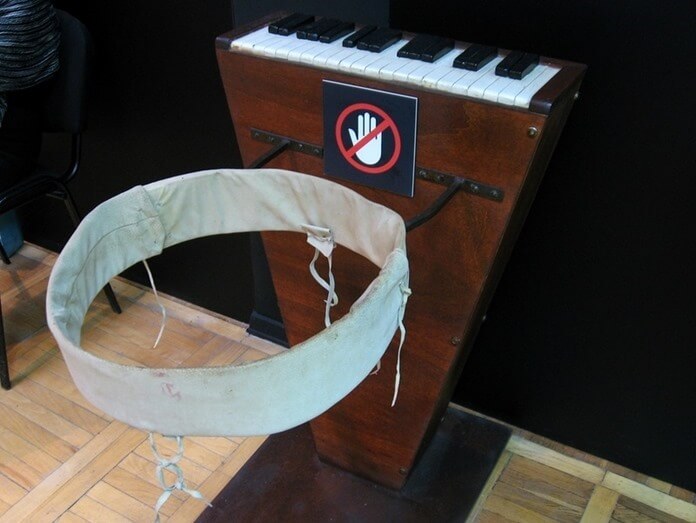 Being a multi-talented person, Leonardo da Vinci was interested in music. And he created a musical instrument that was attached to the musician's belt with a special device. Thus, the person had both hands free and he could play the piano on the go. At the same time, a complex mechanism was involved, which was responsible for the constant contact of the horsehair bow with the strings. The sound extracted from such a device was similar to the sound of a violin.
Being a multi-talented person, Leonardo da Vinci was interested in music. And he created a musical instrument that was attached to the musician's belt with a special device. Thus, the person had both hands free and he could play the piano on the go. At the same time, a complex mechanism was involved, which was responsible for the constant contact of the horsehair bow with the strings. The sound extracted from such a device was similar to the sound of a violin.
15. Submarine

Usually, when the phrase "submarine" is presented, the Nautilus from the works of Jules Verne. However, back in 1515, Leonardo da Vinci created a blueprint for his own submarine. It was designed to sink enemy ships and was operated by one person who was in a small wheelhouse.
According to the author's idea, the sailor was supposed to quietly lead the submarine into the enemy port, and attach a special cable to the skin of the enemy ship.At the other end of the line was a load that had to be thrown into the sea. When the ship set off, the plank upholstery was torn off due to the cargo, and the ship began to sink.
14. Ball bearing
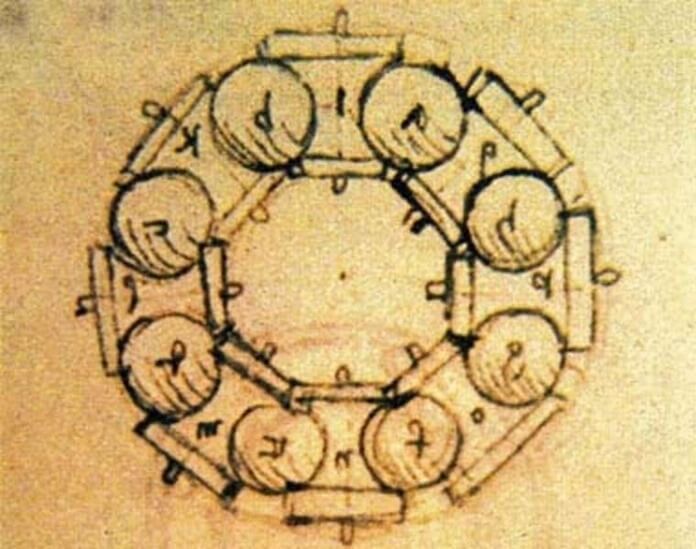 Leonardo da Vinci invented the ball bearing between 1498 and 1500. He designed it to reduce friction between two plates that would be in contact in his other famous project, the helicopter. At the heart of Leonardo's ball bearing was a sliding ring, inside which there were 8 smooth balls. Each ball could move freely, almost without touching each other.
Leonardo da Vinci invented the ball bearing between 1498 and 1500. He designed it to reduce friction between two plates that would be in contact in his other famous project, the helicopter. At the heart of Leonardo's ball bearing was a sliding ring, inside which there were 8 smooth balls. Each ball could move freely, almost without touching each other.
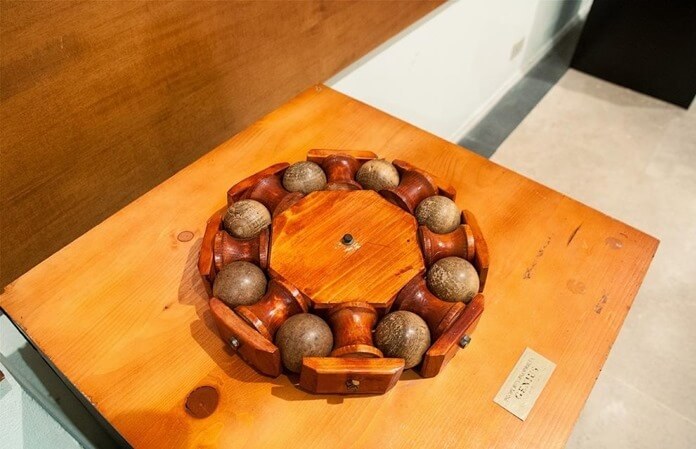
100 years after Leonardo's development, Galileo Galilei also mentioned the early form of the ball bearing. It was only at the end of the 18th century that a patent was obtained for the "modern" design of ball bearings. It was provided to the Englishman Philip Vaughn.
13. City of the future
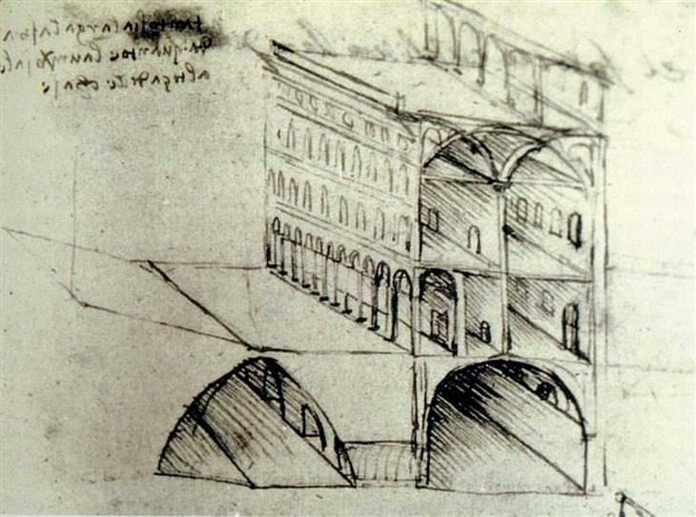
During the 15th century, Europe was still recovering from the Black Death, a plague that wiped out over a third of its population. Da Vinci noted that cities are more vulnerable to plague than rural areas.
His solution was a completely new futuristic city, completely designed from top to bottom to provide the best sanitary conditions for residents. The city of the future Da Vinci was divided into several "layers". Anything that was considered unhygienic had to be located in the lower layer, the contents of which could be removed through the channels. Every part of the city could benefit from running water thanks to a sophisticated hydraulic system that also served as the basis for modern plumbing.
However, da Vinci could not find a patron who would support his interesting, but very expensive endeavor.
12. Scissors
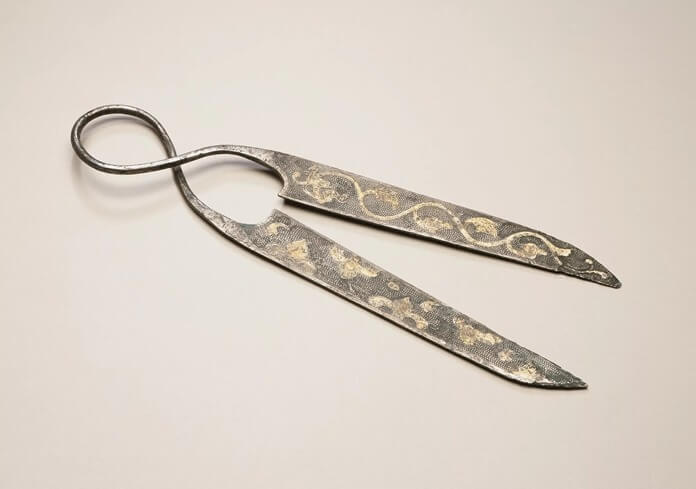 An extremely simple, and at the same time extremely important tool - scissors - was of great importance in the development of mankind. Nonetheless, it is one of da Vinci's more controversial inventions, as archaeological evidence indicates that scissor-like items were used in ancient Egypt and ancient Rome.
An extremely simple, and at the same time extremely important tool - scissors - was of great importance in the development of mankind. Nonetheless, it is one of da Vinci's more controversial inventions, as archaeological evidence indicates that scissor-like items were used in ancient Egypt and ancient Rome.
However, it is undeniable that da Vinci made detailed sketches of the scissors and probably contributed to the improvement of their design.
11. Winged aircraft (hang glider)
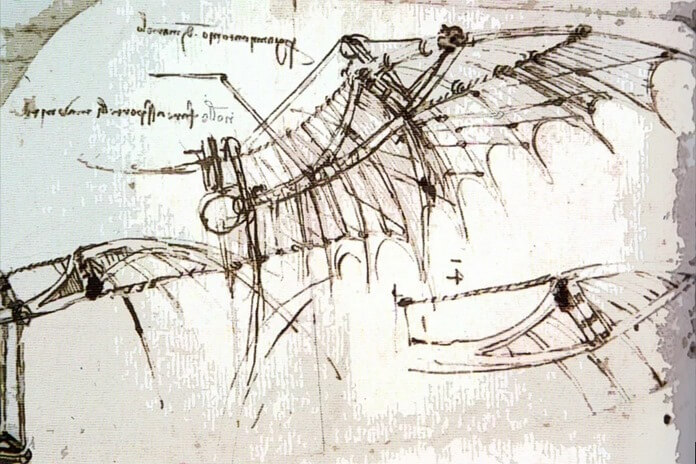 Leonardo da Vinci is the world's first engineer credited with manned flight designs. Discoveries made by Leonardo during countless dissections of the wings of birds and bats are evident in the designs of an ornithopter, a device that flies by flapping winged appendages.
Leonardo da Vinci is the world's first engineer credited with manned flight designs. Discoveries made by Leonardo during countless dissections of the wings of birds and bats are evident in the designs of an ornithopter, a device that flies by flapping winged appendages.
According to Leonardo's calculations, in order to lift his ornithopter into the air (in various publications it is also called a flywheel) with a person on board, bird-like wings are needed, the length of which reaches 12 meters. The weight of the structure itself, together with a person, should have been about 136 kilograms.
 The idea of controlled flight was as follows:
The idea of controlled flight was as follows:
- The pilot had to lie on top of the central wooden plank.
- With his neck and head he held on to the semicircular rim, and with his feet he held on to the rear straps.
- In this position, it was possible to control the glider with the hands or feet. With his hands he would have held on to the frame, and with his feet he would have pressed the pedals, one of which controlled the flapping of the wings, and the second - their lowering.
10. Helicopter
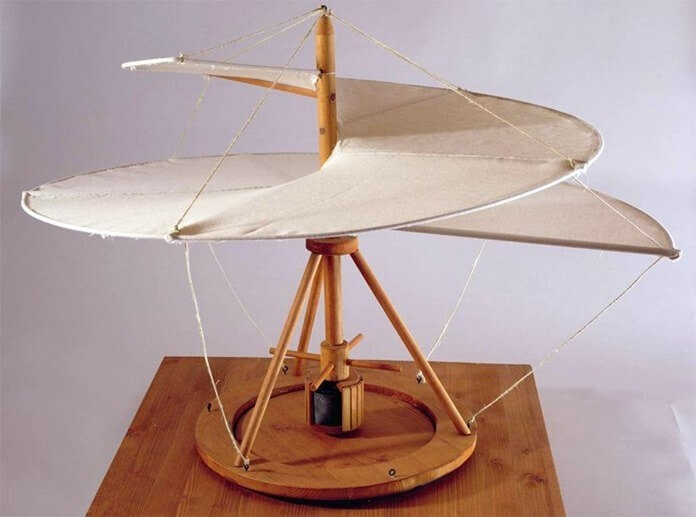 Only Leonardo did not stop at the hang-glider project. His other project is known, conceived in 1493 - a prototype of a vertical aircraft, along with a description of the propeller. This propeller was supposed to be about 5 meters high and a radius of 2 meters. Its covering would be made of iron. The apparatus was supposed to be set in motion by the muscular efforts of four people.
Only Leonardo did not stop at the hang-glider project. His other project is known, conceived in 1493 - a prototype of a vertical aircraft, along with a description of the propeller. This propeller was supposed to be about 5 meters high and a radius of 2 meters. Its covering would be made of iron. The apparatus was supposed to be set in motion by the muscular efforts of four people.
For most of his life, Leonardo da Vinci was fascinated by the phenomenon of flight. He conducted many studies on this mystery of nature, and in 1505 he wrote the Code on the flight of birds, containing both a description of the flight and drawings of his flying machines.
9. Diving equipment
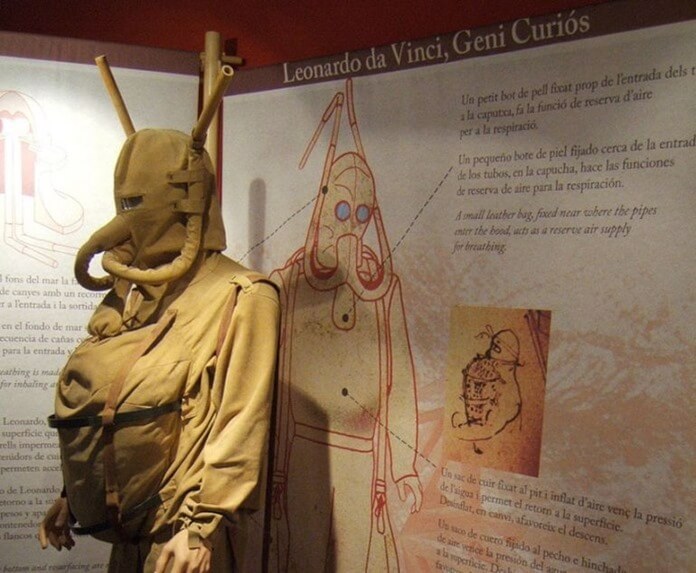
Neither the sky nor the sea was an obstacle for the genius of Leonardo da Vinci. He created the design for the first diving suit, conceived as an unusual weapon to destroy enemy ships.
The diving suit had to be made of leather and had a special mask with two tubes (located in the nose area) that were connected to a cork diving bell floating above the water.
On the chest of the underwater suit there was a large pocket that was filled with air. With its help, the diver could float to the surface.
This nifty contraption was accompanied by a separate section in a suit that would allow the diver to urinate in the event of a long underwater mission.
This suit shows a striking resemblance to systems that are still in use today.
Also Leonardo developed webbed gloves, which are the prototype of modern fins.
8. Giant Crossbow
 The instillation of fear was the main goal of this invention. The giant crossbow was designed purely to intimidate enemy forces. When opened, the length of this structure reached 24 meters. It was located on a platform that had six wheels to make the crossbow mobile.
The instillation of fear was the main goal of this invention. The giant crossbow was designed purely to intimidate enemy forces. When opened, the length of this structure reached 24 meters. It was located on a platform that had six wheels to make the crossbow mobile.
This crossbow could shoot not only arrows, but also large stones. And his bowstring was pulled by mechanical devices.
7. Self-propelled truck (machine)
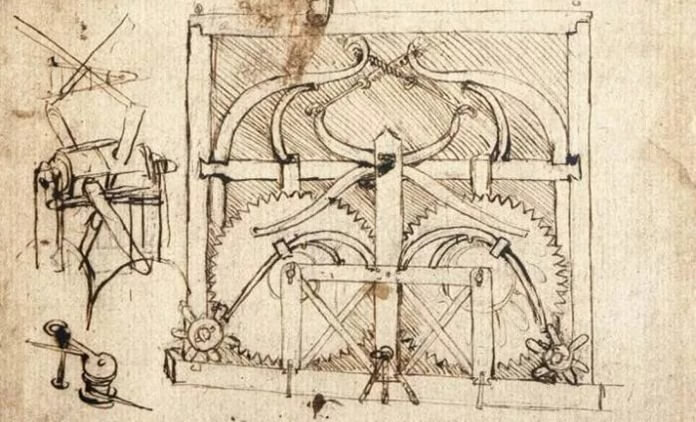 Are you still not impressed by the most famous inventions of Leonardo da Vinci? Then how about he accidentally became a mechanical engineering pioneer? The self-propelled cart, presumably intended for theatrical use, was designed by Leonardo to be moved without being pushed by a person.
Are you still not impressed by the most famous inventions of Leonardo da Vinci? Then how about he accidentally became a mechanical engineering pioneer? The self-propelled cart, presumably intended for theatrical use, was designed by Leonardo to be moved without being pushed by a person.

The device, powered by coil springs, was equipped with brakes and steering systems.
6. Armored vehicle
 If a self-propelled cart is the "great-grandmother" of modern cars, then an armored vehicle is undoubtedly the "great-grandfather" of modern tanks.
If a self-propelled cart is the "great-grandmother" of modern cars, then an armored vehicle is undoubtedly the "great-grandfather" of modern tanks.
The armored vehicle was supposed to have a crew of 8 people inside the hull. In addition, many light cannons were to be located on a massive circular platform. At the same time, their gunner had a field of view of 360 degrees, being in the aiming tower at the top. Leonardo da Vinci even thought about including horses in driving his car, but then abandoned this idea due to the uncontrollable nature of animals.
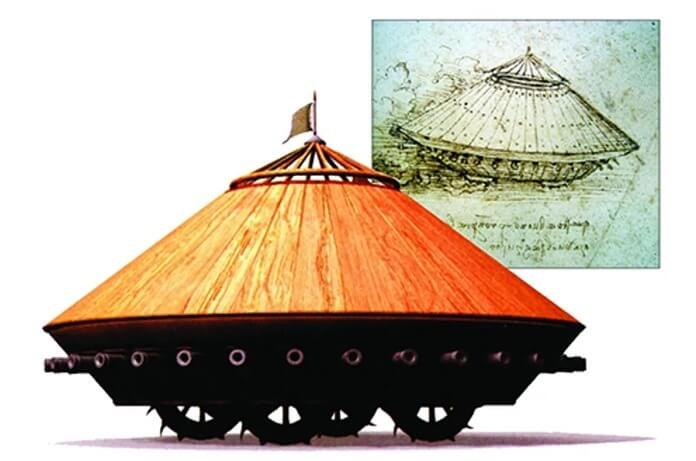
Questions are raised by the location of the armored car's cranking systems, which apparently move in opposite directions. Because of this, the car simply cannot move. Some historians believe this may have been a deliberate decision, since da Vinci's "pacifist" did not want his war machines to be used for actual combat. A somewhat strange assumption, because the same da Vinci created the predecessor project for modern machine guns and a giant crossbow.
5. Anemometer
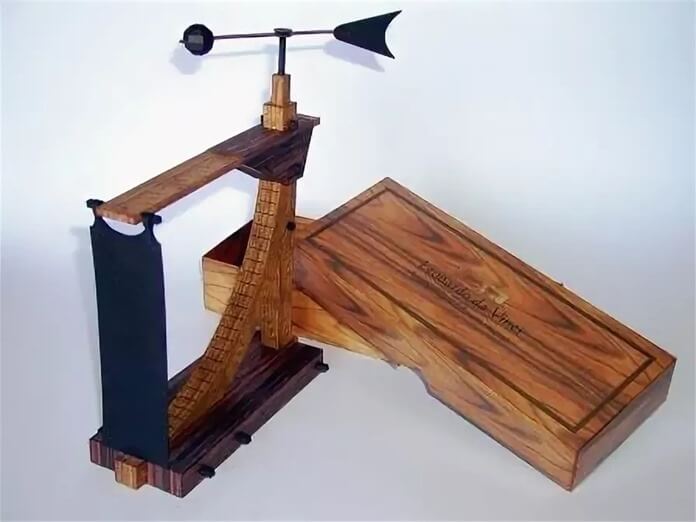 In connection with the study of flight, Leonardo developed a new design of the anemometer, a device that measures wind speed. Its additions to Leon Batista's original design made the device significantly more accurate.
In connection with the study of flight, Leonardo developed a new design of the anemometer, a device that measures wind speed. Its additions to Leon Batista's original design made the device significantly more accurate.
4.33-barreled cannon (machine gun)
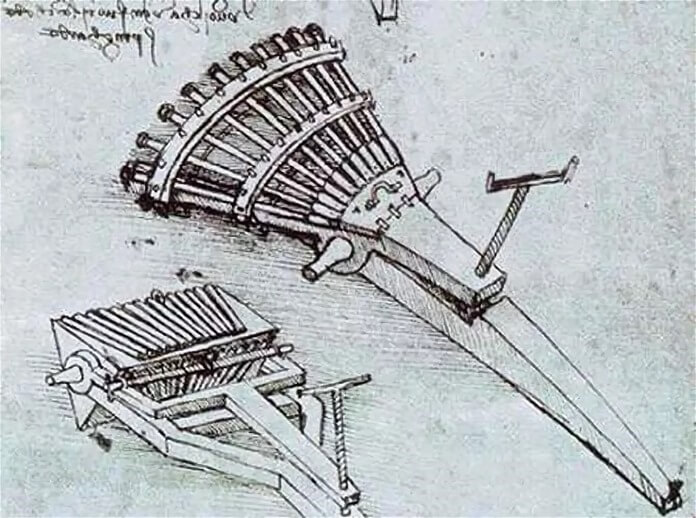 Leonardo was deeply disturbed by the inadequacy of the wars of his day. In particular, he was frustrated by the time lag between cannon shots due to the need to reload. To solve this problem, he invented a multi-barreled cannon, consisting of three rows of 11 small-bore cannons, mounted on a triangular rotating platform with large wheels.
Leonardo was deeply disturbed by the inadequacy of the wars of his day. In particular, he was frustrated by the time lag between cannon shots due to the need to reload. To solve this problem, he invented a multi-barreled cannon, consisting of three rows of 11 small-bore cannons, mounted on a triangular rotating platform with large wheels.
Such a weapon could be rotated and fired from one row of cannons while the other was reloading and the other one was cooling.
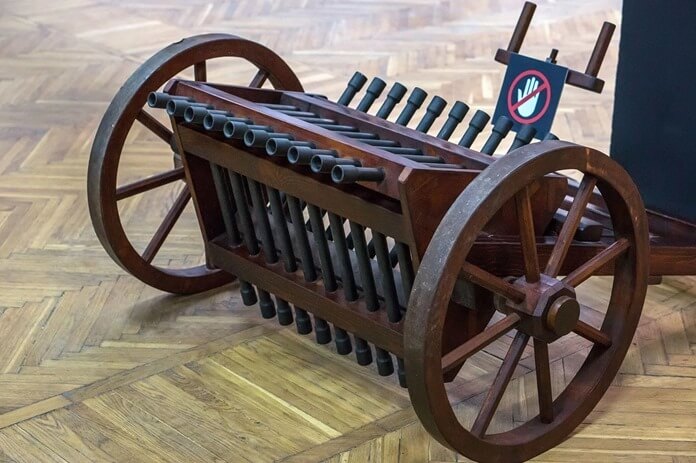
Interestingly, multi-barreled salvo weapons were actually used in various forms even before da Vinci was born (similar to the Ribodequin used during the Hundred Years War). However, da Vinci's 33-barreled "combat organ" was more like 19th-century machine guns - like the Gatling machine gun, which boasted a higher rate of fire without the problem of barrel overheating.
3. Swivel bridge
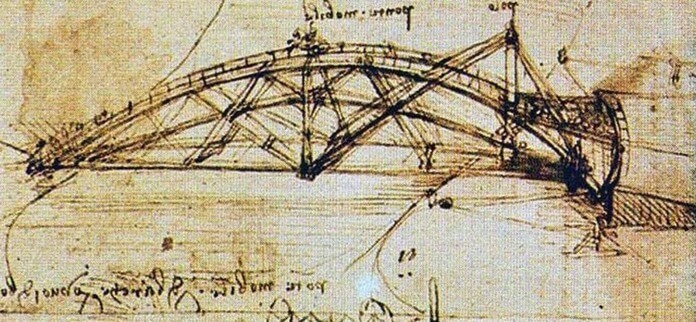 The Leonardo Sliding Swing Bridge was not only an engineering marvel and a huge military innovation, but also a curious early example of flat design.Designed in the 1480s for the Duke of Sforza, the bridge allowed troops to cross rivers quickly and could be easily assembled and transported for reuse elsewhere.
The Leonardo Sliding Swing Bridge was not only an engineering marvel and a huge military innovation, but also a curious early example of flat design.Designed in the 1480s for the Duke of Sforza, the bridge allowed troops to cross rivers quickly and could be easily assembled and transported for reuse elsewhere.
In technical terms, it was assumed that the bridge will have a counterweight that will balance the structure on both sides. In terms of ease of transport, the design has been developed using wheels and a rope-pulley system for efficient deployment in a short amount of time.
2. Parachute
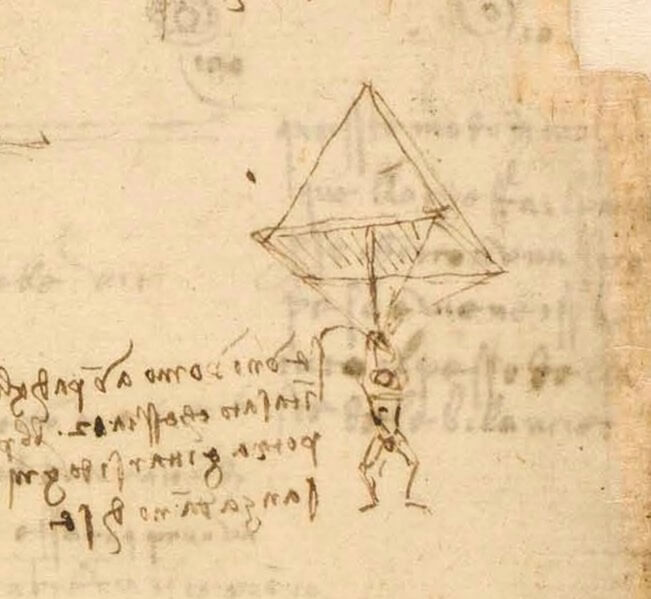 Although the creation of the first parachute is often credited to the Frenchman Louis-Sebastian Lenormand in 1783, evidence has been found to indicate that the Italian genius was the first in this area.
Although the creation of the first parachute is often credited to the Frenchman Louis-Sebastian Lenormand in 1783, evidence has been found to indicate that the Italian genius was the first in this area.
His sketch is accompanied by an annotation: "If a person has a linen tent, which has all openings closed, and it is twelve cubits wide and twelve cubits deep, he will be able to throw himself down from a tall height without any injury."
1. Robot Knight
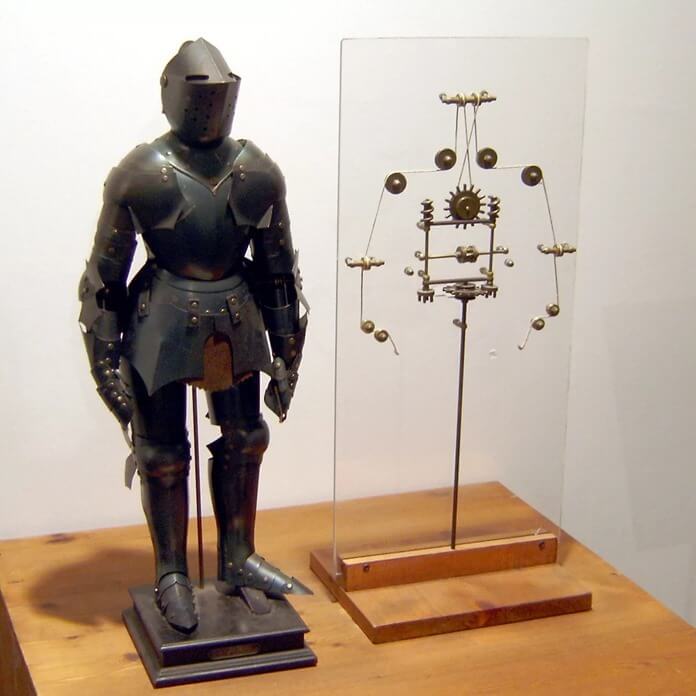 Dressed in heavy German-Italian medieval armor, the mechanical knight was conceived in 1495 as a humanoid machine gun. With an internal system of pulleys, gears, levers and connecting rods, this machine was in fact the first humanoid robot in human history.
Dressed in heavy German-Italian medieval armor, the mechanical knight was conceived in 1495 as a humanoid machine gun. With an internal system of pulleys, gears, levers and connecting rods, this machine was in fact the first humanoid robot in human history.
According to some reports, the ingenious invention of Leonardo da Vinci was presented in Milan during a gala event organized by Duke Lodovico Sforza.
The robot, powered by internal mechanisms (evenly distributed over the torso and lower body), presumably had the ability to both sit up and stand up, while demonstrating its ability to move its head.
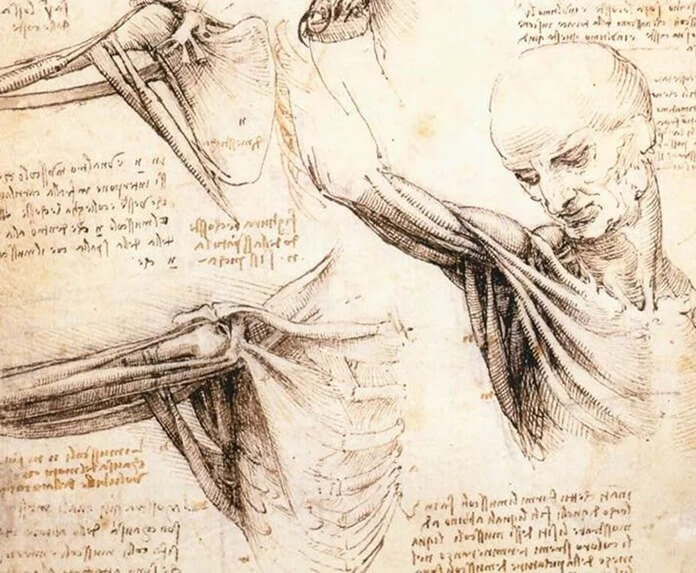
The internal system of pulleys and levers in the robot knight mimicked Leonardo's anatomical observations of the muscular structure of humans.

